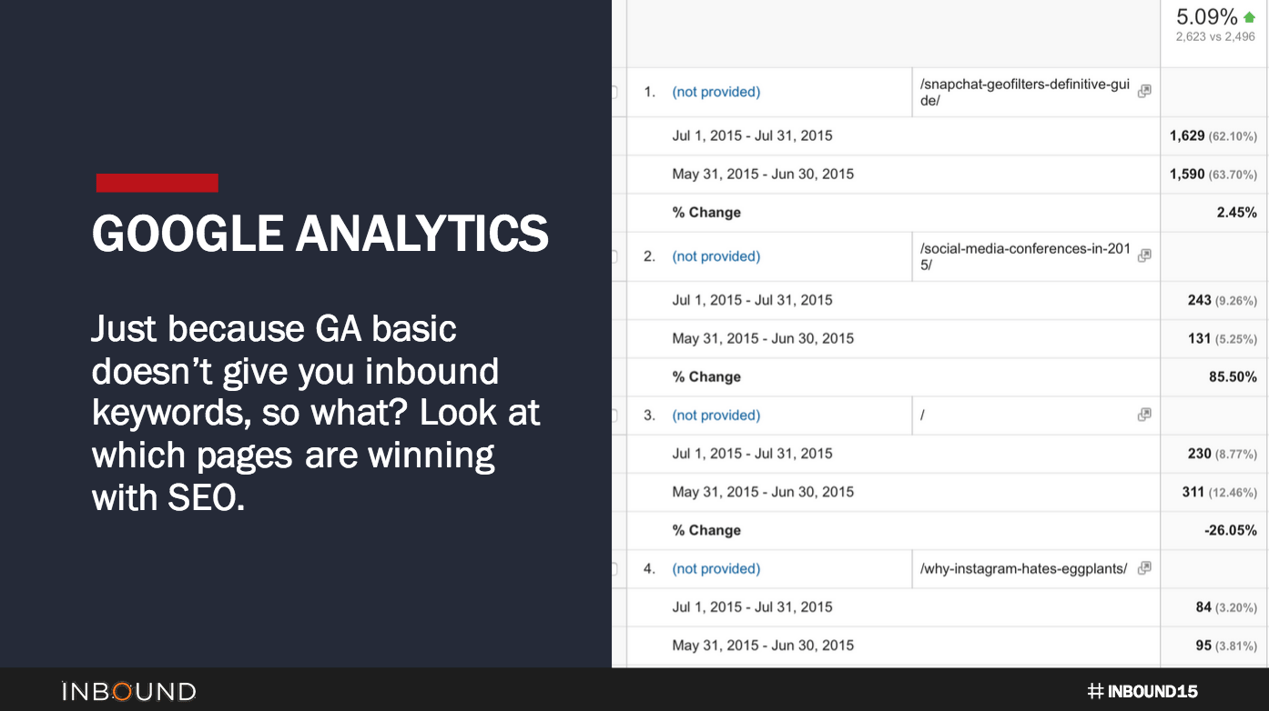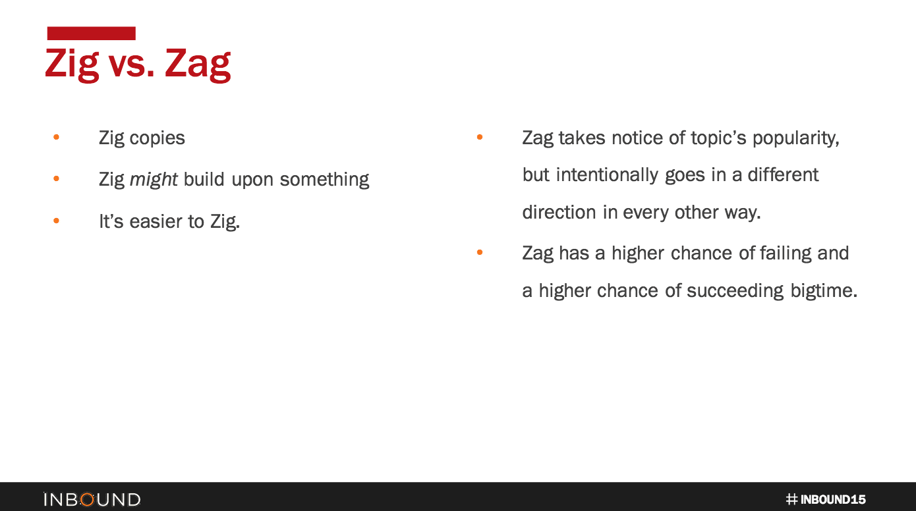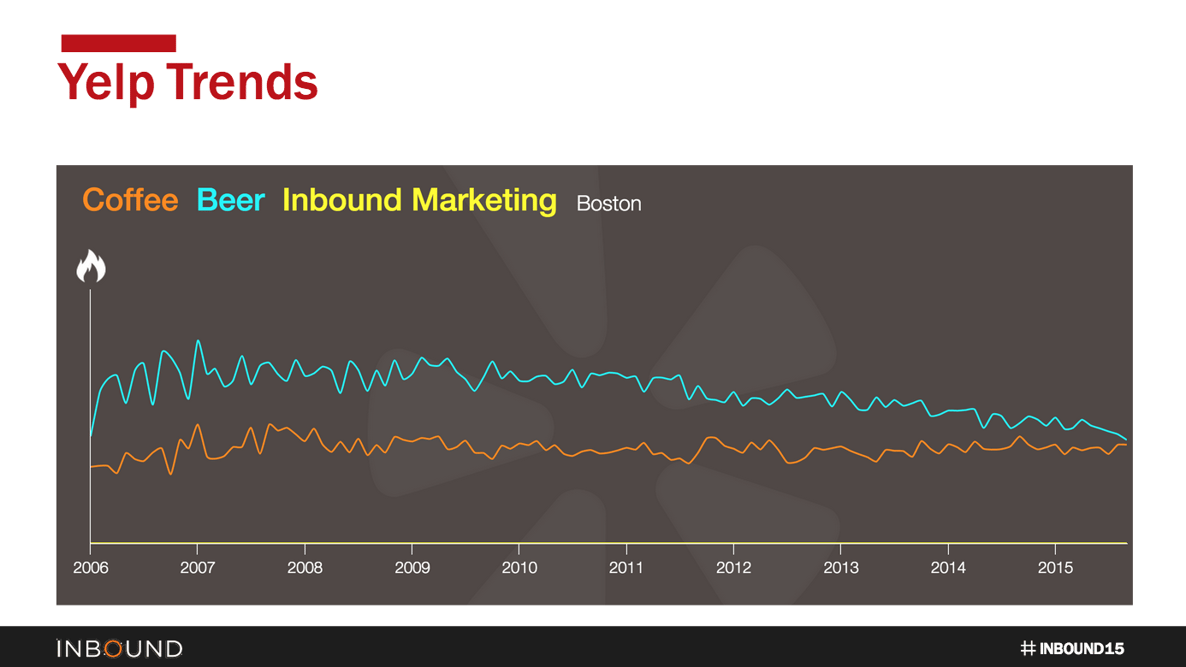
At Inbound 2015 in Boston last week, Jeremy Goldman discussed ways to take insights from your marketing analytics and convert them into stellar content. I snagged a great seat at his encore session and it's no wonder that these seats were in such high demand.
Whether you’re using your analytics or someone else's, when used correctly, you’ll be able to create content that is timely, interesting, and relevant to your buyer personas. Check out this extensive list of tools and tips that we gained from his session.
Using Your Own Analytics
Tool: Lead Forensics
This is a reverse IP lookup tool for tracking visitors and better understanding your audience. ![]() It is especially great for B2B companies because you can identify the companies that visitors to your website belong to. Once you have your lists of visitors, identify which of your persona they relate to, and create content based on your lists.
It is especially great for B2B companies because you can identify the companies that visitors to your website belong to. Once you have your lists of visitors, identify which of your persona they relate to, and create content based on your lists.
Tool: Google Analytics SEO Traffic
Use this tool to monitor your site's performance on a daily basis. You can see winning pages and build more pages relevant to that content. Be sure to look at SEO traffic versus regular traffic because tweets could skew your data.

(Image from Jeremy Goldman's PPT presentation)
Tool: Twitter Redirect Link
Take the t.co bit code from Google Analytics and plug it into Google search to see what page it is. ![]() This is a good way to find out what pages are doing well for you so you can take these top pages and strategize your upcoming content around them.
This is a good way to find out what pages are doing well for you so you can take these top pages and strategize your upcoming content around them.
Using Everyone Else's Analytics
Jeremy identified two types of content that can be created from analyzing the content of others: Zig and Zag.
- Zig: Taking content topics that are already popular and recreating it. This is an easier approach to content than Zag in that you are building off of already existing content.
- Zag: Take notice of something popular, but implement a different approach or aspect to actually create your content. This approach is a lot more volatile because you are potentially setting yourself up for a huge win or huge fail and you won’t know the outcome until it’s actually out there for your fans to see. “Home runs are hit with a zag.”

(Image from Jeremy Goldman's PPT presentation)
Tool: Google Trends
Use Google Trends to find out what people are interested in and discover where these people are in the world. Are they in your town? Maybe you can host a meet up for a niche group that can benefit from your product.
It’s also worth stating that you shouldn’t always go after creating content that everyone is jumping on. ![]() Less competition can be just as good for your business in that you’ll catch fewer eyes, but these eyes will be readier to buy - or at least look.
Less competition can be just as good for your business in that you’ll catch fewer eyes, but these eyes will be readier to buy - or at least look.
Tool: YouTube Trends
Use this tool to help you identify what's trending by locations and gender. You can also compare trending topics.
Tool: Twitter Curator
You need to request access to this one. But if you are able to get in, take full advantage. Media publishers are able to discover the best Twitter content on any screen in real time.
Tool: Visible Tweets
This is arguably more cool than useful. Enter a term that may be trending on Twitter and a more visually pleasing version of tweets with that term will fade on and off of your screen.
Tool: Rad URLs
If Google Trends aren’t real-time enough for you, you can find the most shared content and also know the velocity of them with Rad URLs.
Tool: Feedly
Similar to Rad URLs, with Feedly, you can search for existing content that your audience would love and you can also see the number of shares per post. This gives you a good idea of what content you can use to do a quick zig.
Tool: Facebook Trends
This process entails a little outside of the box thinking, but it is a great hack. Hence, there isn't a direct link to send you to. Proceed as if you were going to post a link to Facebook and it will give you suggested links based on what content your link entails. Take those suggested links and use the content to create your own content.
Tool: Bing Trends
This one is really neat. Search for “Bing Trends” and a quiz of 10 question based on popular searches for the week in Bing will pop up. Take the quiz just for fun or use it to create content based on trending searches.
Tool: Job Trends on Indeed.com
Find out what career terms are growing and find which keywords to use. Indeed shows a graph with the percentage of jobs they find that contain the search term you enter. This can be used for content to attract people to positions you are hiring for. That's still important content to create too, right?
Tool: Yelp Trends
You can look up places in a geographical area to see what people are actually interested in. More so, you can compare trends in an area to see which is more popular. In Jeremy’s example, he used coffee, beer, and inbound marketing in Boston. It seems like 'inbound marketing' could use some help.

(Image from Jeremy Goldman's PPT presentation)
Tool: Wordle
Similar to Visible Tweets, this tool may be more fun than useful. With Wordle, you can generate “word clouds” from text that you provide. ![]() Words that appear more frequently in the source text will be bigger to illustrate their prominence.
Words that appear more frequently in the source text will be bigger to illustrate their prominence.
Real-Time Content Creation Best Practices
-
Don't Overthink It - By the time you’re done thinking, everyone will be on to the next trending topic. Keep the process short, simple, relevant, interesting, and to the point.
-
Limit Your Time - Give yourself 20-30 minutes to create a piece of content. Whatever you’ve completed in that timeframe is what you should go with.
-
Be Relevant to Your Audience - Start with the objective and work backward. Focus on creating content that is relevant and will help you meet your objective.
-
Plagiarizing is AWFUL - There are many plagiarism checkers online. You must choose the best and free plagiarism checker for your content. And you know the saying, "once a plagiarizer, always a plagiarizer." This may not always be the case, but people will question the validity of all other articles if one is plagiarized. Don’t take that chance.
- Give Credit Where Credit is Due - Thank people and link to them. Take it a step further and tweet them. Let them know you referenced their work. This will help you in two ways, making yourself credible, and building a relationship.
With all of these tips and tools, you're ready for the next inbound marketing step! Click below to continue on in your journey toward customer-converting content that shines.


